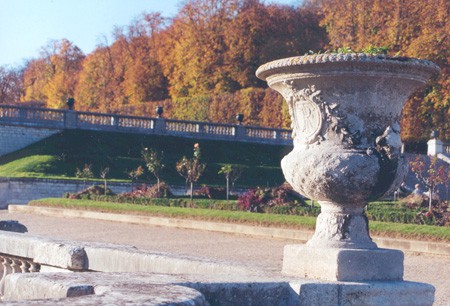The Château de Saint-Cloud was the scene of some of the significant moments in French 19th century history, and most notably in Napoleonic history in that it saw the rise and fall of both the First and Second Empires. Bonaparte seized power there in his coup d'etat of 18 Brumaire, and the Empire was proclaimed from here in a Sénatus-Consulte of 18 May 1804. It was again at Saint-Cloud that the capitulation of Paris was signed, 3 July 1815. In 1830, Charles X was to sign here the Ordonnances which were to lead to his downfall. On 2 December 1852, the Prince-President Louis-Napoleon was named Emperor and on 17 July 1870 the declaration of war against Prussia was signed. Three months later, the Empire in tatters, the château went up in flames.
In the 16th century, the Gondi family built a residence, surrounded by 12 hectares of gardens and terraces, at Saint-Cloud on a slope overlooking the Seine and Paris. In 1658, Louis XIV bought the house as a country villa for his brother Philippe, the future Duc d'Orléans. In the period from 1660-1690, the house was made into a château by Antoine Le Pautre and Jules-Hardoin-Mansart, whilst Le Nôtre laid a park of 460 hectares of which the principal ornament (still-existing today) is the Grand Cascade, one of the most remarkable feats of hydraulic engineering of the 17th century. The house was occupied by the d'Orléans family for the whole of the 18th century, but in 1785 it was purchased by Louis XVI who gave it to Marie-Antoinette. Richard Mique, the architect of the Queen's ‘hameau' at Versailles, refurbished the château, but with the onset of the Revolution most of this furniture was dispersed. Saint-Cloud was however to escape the dismantling suffered by all the other royal properties when in 1793 the Convention passed a decree stipulating that ‘the park and château should be preserved and maintained at the expense of the Republic for the pleasure of the people'.
The coup d'etat of 18 Brumaire (9 November 1799) took place at Saint-Cloud (more precisely) on 19 Brumaire. On the pretext of fear of a conspiracy, the two national assemblies were transferred to the château – the Conseil des Anciens to the Galerie d'Apollon and the Cinq-Cents to the Orangerie. Bonaparte's soldiers then invaded the Orangerie, driving out the députés and confirming the establishment of a power which put an end to the moribund Directory and gave birth to the Consulate.
In October 1801, the First Consul emitted a decree ordering the reappointment of the château. The palace, in its rearranged and refurbished state, became the official centre of consular and subsequently imperial power. As a result Saint-Cloud was the scene of many significant political and personal Napoleonic events, notably: the proclamation of the empire in 1804 in the Galerie d'Apollon; the baptism of Louis-Napoleon by Pope Pius VII in 1805; the civil marriage of Napoleon and Marie-Louise in 1810; the celebrations for the baptism of the King of Rome in 1811…
The Second Empire saw Saint-Cloud return to its former glory. After his proclamation as Emperor, Napoleon III made the château one of the official residences of the imperial court and a place of government. Just as with the Tuileries, Napoleon here performed his role as head of state, holding council and giving grand receptions in honour of ambassadors or visiting monarchs, such as for example for: Queen Victoria in 1855; Charles XV of Sweden in 1861, the Khedive Ismael in 1869; etc.
The château was occupied on 19 September 1870 during the Franco-Prussian war and blown up by incendiary shells fired from nearby Mont Valérien on 13 October. Despite the fact the château could have been restored (as photographic evidence shows) and some of the furniture saved, it was decided to demolish the building, charged as it was with too many ambivalent historical memories. The ruins were razed in 1891 and stones were sold at auction. The Czar Ferdinand of Bulgaria bought the pediment of the right-hand wing of the château for his house in Euxinograd, a pediment from the left-hand wing is on the Château de Jeurre near Etampes, the main portcullis is at the Château de la Punta in Ajaccio and the bas-reliefs from the staircase are in the Château de Laeken in Belgium.
Today all that remains of this site which so forcefully left its imprint on the history of France, is the park, the small museum, and the outbuildings (occupied by the Ecole Normale Supérieure). The park – one of the most beautiful in the Paris region – contains the terrace on which the château was built (yew bushes mark the position of the main courtyard and some of the rooms). Remarkable features in the garden are: the Grande Cascade, the Fer-à-Cheval pool, the Trocadéro garden, the Allée des statues, the line of 24 small fountains, the Vingt-Quatre Jets, the Tapis vert lawn, the Grande Gerbe fountain etc. The Allée de la Balustrade leads to the Terrasse de la Lanterne, a site which soars 94 metres above the Paris skyline. It was here that Napoleon had built a tower called the Lanterne de Demosthène, a copy of the monument to Lysicrates in Athens. This when lit used to signify that the Emperor was in residence. This too was destroyed during the war of 1870.
Domaine national de Saint Cloud – Park and Historical Museum


